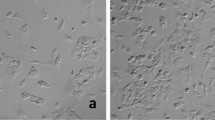Summary
A transitional cell carcinoma cell line, COLO 232, was derived from a primary urinary bladder tumor in a Caucasian male. In culture, COLO 232 retained distinct uroepithelial phenotypic traits and produced both carcinoembryonic antigen and adrenocorticotropic hormone. COLO 232 had a chromosome mode of 58 and retained the X and Y chromosomes. Ten marker chromosomes were identified. COLO 232 will be of value for biochemical and immunological studies.
Similar content being viewed by others
References
Moore, G. E., R. E. Gener, and H. A. Franklin. 1967. Culture of normal human leukocytes. J. Am. Med. Assoc. 199: 519–524.
Woods, L. K., G. E. Moore, C. J. Bainbridge, C. C. Huang, C. Huzella, and L. A. Quinn. 1973. Lymphoid cell lines established from peripheral blood of persons with Down's syndrome. N. Y. State J. Med. 73: 869–873.
Ham, R. G. 1965. Clonal growth of mammalian cells in a chemically defined synthetic medium. Proc. Nat. Acad. Sci. U.S.A. 53: 288–293.
Moore, G. E., S. B. Merrick, L. K. Woods, and N. M. Arabasz. 1975. A human squamous cell carcinoma cell line. Cancer Res. 35: 2684–2688.
Lubs, H. A., W. H. McKenzie, S. R. Patil, and S. Merrick. 1973. New staining methods for chromosomes. In: D. M. Prescott (Ed.),Methods in Cell Biology. Vol. 6. pp. 346–380.
Seabright, M. 1971. A rapid banding technique for human chromosomes. Lancet 2: 971–972.
McKenzie, W. H., and H. A. Lubs. 1973. An analysis of technical variables in the production of C bands. Chromosoma 41: 175–182.
Krutzik, S. 1976.Radioimmunoassay Manual. 3rd Edition. Nichols Institute, San Pedro, Calif., pp. 209–220.
Eipper, B. A., and R. E. Mains. 1975. High molecular weight forms of adrenocorticotropic hormone in the mouse pituitary and in a mouse tumor cell line. Biochemistry 14: 3836–3844.
Chen, T. R. 1975. Microscopic demonstration of mycoplasma contamination in cell cultures and cell culture media. Procedure 75361. TCA Manual 1: 229–232.
Mizrahi, A., and G. E. Moore. 1971. Long-term preservation of permanent human hematopoietic cell lines. J. Med. 2: 380–386.
Firth, J. A., and R. M. Hicks. 1973. Interspecies variation in the fine structure and enzyme cytochemistry of mammalian transitional epithelium. J. Anat. 116: 31–43.
Quinn, L. A., L. K. Woods, S. B. Merrick, N. M. Arabasz, and G. E. Moore. 1977. Cytogenetic analysis of 12 human malignant melanoma cell lines. J. Nat. Cancer Inst. 59: 301–307.
O'Toole, C., S. Mayak, Z. Price, W. H. Gilbert, and J. Waisman. 1976. A cell line (SCaBER) derived from squamous cell carcinoma of the human urinary bladder. Int. J. Cancer 17: 707–714.
Elliot, A. Y., P. Cleveland, J. Cervenka, A. E. Castro, N. Stein, T. R. Hakala, and E. E. Fraley. 1974. Characterization of a cell line from human transitional cell carcinoma of the urinary tract. J. Nat. Cancer Inst. 53: 1341–1349.
Rigby, C. C., and L. M. Franks. 1970. A human tissue culture cell line from a transitional cell tumor of the urinary bladder: Growth, chromosome pattern and ultrastructure. Br. J. Cancer 24: 746–754.
Bubenik, J., M. Baresova, V. Viklicky, J. Jakoubkova, H. Sainerova, and J. Donner. 1973. Established cell line of urinary bladder carcinoma (T24) containing tumor-specific antigen. Int. J. Cancer 11: 765–773.
Rasheed, S., M. B. Gardner, R. W. Rongey, W. A. Nelson-Rees, and P. Arnstein. 1977. Human bladder carcinoma: Characterization of two new tumor cell lines and search for tumor viruses. J. Nat. Cancer Inst. 58: 881–890.
Liddle, G. W., W. E. Nicholson, D. P. Island, D. N. Orth, K. Abe, and S. C. Lowder. 1969. Clinical and laboratory studies of ectopic hormonal syndromes. Rec. Prog. Horm. Res. 25: 283–293.
Morgan, R. T., L. A. Quinn, L. K. Woods, and G. E. Moore. 1977. Marker properties of tumor and lymphoid cell lines derived from a patient with squamous cell carcinoma. Cancer Res. 37: 2030–2035.
Gerwirtz, G., and R. S. Yalow. 1974. Ectopic ACTH production in carcinoma of the lung. J. Clin. Invest. 53: 1022–1032.
Leibovitz, A., J. C. Stinson, W. B. McCombs, III, C. E. McCoy, K. C. Mazur, and N. D. Mabry. 1976. Classification of human colorectal adenocarcinoma cell lines. Cancer Res. 36: 4562–4569.
Drewinko, B., M. M. Romsdahl, L. Y. Yang, M. J. Ahearn, and J. M. Trujillo. 1976. Establishment of a human carcinoembryonic antigenproducing colon adenocarcinoma cell line. Cancer Res. 36: 467–475.
Author information
Authors and Affiliations
Additional information
This work was supported by Grant No. CA 15018 awarded by the National Cancer Institute, DHEW, and the Mary B. and L. H. Marshall Fund.
Rights and permissions
About this article
Cite this article
Moore, G.E., Morgan, R.T., Quinn, L.A. et al. A transitional cell carcinoma cell line. In Vitro 14, 301–306 (1978). https://doi.org/10.1007/BF02616040
Issue Date:
DOI: https://doi.org/10.1007/BF02616040




